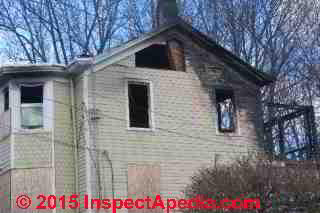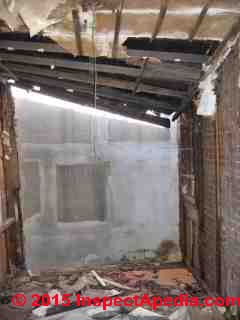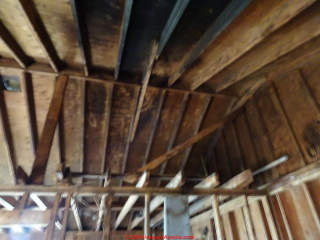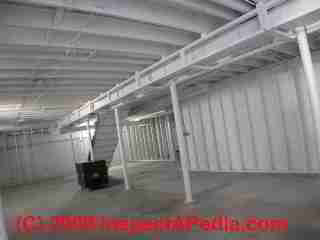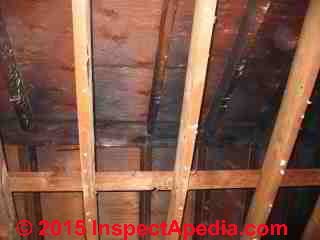 Building Fire & Smoke Odor Removal
Building Fire & Smoke Odor Removal
Find & Remove Persistent Sources of Fire or Smoke Odors & Smells
- POST a QUESTION or COMMENT about how to track down & remove or cure fire & smoke odors in buildings, vehicles, or other enclosed spaces
Fire & smoke odor causes, reservoirs, & removal methods:
This article describes seven approaches people use to attempt (with mixed success) to remove fire or smoke odors from buildings, building contents, or from other enclosed spaces. We also discuss: how does fire cause lingering odors in buildings even where some items are not visibly burned?
How to deal with cigarette or cigar smoke odors. Research on fire & smoke odor control & removal; professional odor fire restoration associations can help find a diagnostic or fire/smoke damage clean-up expert
Our page top photo shows a skunk running from a smelly building fire. Not really.
InspectAPedia tolerates no conflicts of interest. We have no relationship with advertisers, products, or services discussed at this website.
Smoke & Fire or Burned Food Odors in Buildings
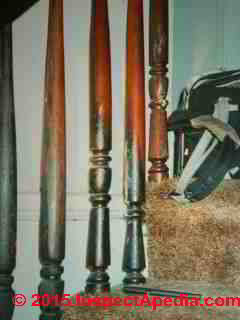 Odors building fires, cigarette or cigar smoke, heating system malfunctions, from wood stoves etc. require special expertise for effective remediation - - clean, seal, track down remaining odor sources & clean, seal, or remove the remaining smell source
Odors building fires, cigarette or cigar smoke, heating system malfunctions, from wood stoves etc. require special expertise for effective remediation - - clean, seal, track down remaining odor sources & clean, seal, or remove the remaining smell source
This article describes the procedures used to remove fire & smoke odors from buildings, building contents, vehicles etc. This article also warns about ineffective and even harmful (but popular) methods that try to deodorize smoke or fire smells and don't work or worse, cause further damage.
[Click to enlarge any image]
Article Contents:
7 Approaches to removing fire, smoke and many other building odors
- Removal of damaged or smelly materials & Items:
Remove burned, contaminated, damaged materials that cannot be economically cleaned such as drywall that has been wet, carpeting, upholstered furniture.
While some sources recommend removing and washing carpets, in our experience only valuable rugs & carpets that can be professionally cleaned are likely to tolerate soaking without generating a costly mold contamination problem. Wall-to-wall carpets that have been wet should be disposed-of along with their padding. - Cigarette smoke stains & odors:
has received a stunning amount of attention. Steps listed in this article and aimed at getting rid of smoke odors depend in part on the environment and the situation.
For example, special ventilation systems and cigarette smoke odor control equipment is used in areas frequented by smokers. See the citations provided at the end of this section. See Leaderer (1967) and Okubo (2001) et als.
At STAINS HUMAN OCCUPANT we discuss using sealants to cover and seal stains that are not sufficiently-removed by surface cleaning.
These sealants are particularly helpful in dealing with both stains and odors left-over from fires, mold, oil spills, pets, or heavy smokers in buildings. - Cleaning:
Clean building surfaces and clean building contents that can be economically cleaned.
Generally, hard-surfaced building contents and un-upholstered furniture can be cleaned (though experts warn that finishes may have been damaged by heat and may be odor sources).
Soft goods that can be laundered or dry-cleaned can usually be cleaned of fire, smoke or other odor problems.
Valuable upholstered furnishings may be salvageable if treated by an expert conservationist.
Carpeting or area rugs that were not wet or damaged but emits smoke odors might respond to professional cleaning. Carpeting that has been wet or flooded by fire extinguishment, along with its padding, will need to be replaced.
See CARPET MOLD / ODOR TESTS for carpeting or rugs that have been wet and may be mold-contaminated
Cleaning of building surfaces & contents may involve HEPA vacuuming, or where an item can be washed without further damage, actual washing with cleaning solutions. For valuable items & artifacts you should consult a expert conservator or fire damage restoration consultant. - Sealing:
Seal building surfaces using an odor-sealant coating - specific products are available for fire damaged buildings.
Also see MOLD SANITIZER, SPRAY, BIOCIDE USE GUIDE - Ventilating:
use fresh air to remove airborne odors in the building and to help remove odors remaining in building contents or on building surfaces.
Ventilation will not, however, remove an actual odor source such as heat-damaged coatings, furnishings, building contents that have been chemically changed by exposure to a fire or heat.
Watch out: while portable or even central air purifiers and air cleaners may improve odor levels indoors, none of these devices can remove an odor from a building where a persistent source is present. The source needs to be identified and removed or treated. - Heating:
Removing building or vehicle or other enclosed-space odors using heat - thermal deodorization.
Watch out: experts do not recommend this approach for fire-cleanup where items involved have already been affected by heat and may be damaged still more by further exposure to heat - Ozone generators:
Watch out: Using ozone generators in an attempt to remove odors is generally ineffective for smoke, mold, and some other building odor sources and in fact excessive use of ozone in buildings or in other enclosed spaces such as in a moldy car or other vehicle can oxidize various materials creating a new odor problem and ultimately increasing the cost of the odor remedy (as those new smelly materials will probably have to be tossed out)
In our opinion, wet scrubbers (Dickerson 1974) or photocatalyst plasma air cleaning approaches(Lee 2003) hold more promise in this area and may avoid the oxidation issue.
Reader Question: used ozone to remove protein smoke odor, now strange odor remains
My house was cleaned with ozone in order to remove the protein smoke odor. It was cleaned and re-painted as well: ceiling and walls. Now I have strange odor, which is not a smoke.
I suspect the oxidants odors coming from surfaces. It is clear how to remove the odor from the carpet - replace the carpet. However, I do not really understand how to remove it from the walls. Should I re-seal and re-paint the walls? If yes, what paint should I use?
This question was originally posted at OZONE MOLD / ODOR TREATMENT WARNINGS
The house fire image at left illustrates severe fire damage likely to leave further odor problems that will need to be addressed as part of the restoration. This is not the fire discussed by Michael above.
Reply: what is in smoke & why odors remain after an odor-treatment program
Michael,
Really? "Protein smoke odors" ?
Smoke is basically comprised of small but visible particles of unburned material, typically carbon or other substances made airborne during a fire. "Small" here means particles in pm 2.5 range such as wildfire smoke - all particulate matter that is less than ten microns in diameter (10u).
These very small particles can be breathed deeply into the lungs. What's in smoke depends on what was being burned: wood, fabrics, plastics, or food contribute different particles and chemicals to the smoke.
Besides carbon particles, smoke can contain a variety of harmful substances besides particles themselves: gases such as from wood smoke (say burning a wood-framed building or from a wood fire) include acetic acid, benzene, carbon monoxide (CO), formaldehyde, formic acid, heavy metals, nitrogen-oxides (NO2), phenols, sulfur dioxide (SO2), VOCs, and other materials.
Protein odors are the result of burning meat such as a steak, or burning animal fat. You can have a hard time removing these odors from a building.
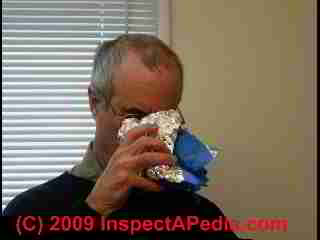 The odor that remains after a building fire, or after burning a steak, is due to outgassing of odor molecules from incompletely-burned particles that plate out on building surfaces (ceilings, floors, walls, carpets, furniture, draperies, etc) after a fire.
The odor that remains after a building fire, or after burning a steak, is due to outgassing of odor molecules from incompletely-burned particles that plate out on building surfaces (ceilings, floors, walls, carpets, furniture, draperies, etc) after a fire.
Since you describe an odor complaint that remains after a post-fire treatment it is most likely that the odor is coming from one or more building surfaces.
People's complaints of odors that remain or that are "new" after post-fire odor-treatments typically come from one of two underlying sources:
Surfaces or materials that have received deposits of burned materials have not been adequately cleaned, sealed, or removed and are continuing to release molecules (or even particles) that smell.
The treatment itself, if it was not properly conducted, can produce new odors and smells from a sealant coating or from over-dosing with ozone as is discussed in this article series.
Therefore, before using an odor sealant (such as is used after a fire) and before repainting, you might have better and more economical success by identifying the odor source.
Try the easy smell patch test kit described at
SMELL PATCH TEST to FIND ODOR SOURCE - at above left the author demonstrates this a smell-patch test that can be used to track down odors to their source in buildings.
When you've identified where the odors are coming-from you have a much better chance at a successful odor-cure.
Odor Sealing Paints
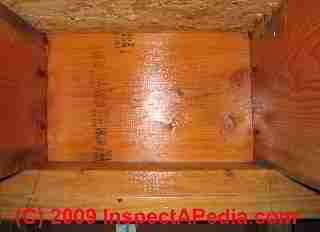 Low-odor, low VOC paints & other special coatings used to help seal odors from fire-heated or fire damaged structures. Also intumescent sealants.
Low-odor, low VOC paints & other special coatings used to help seal odors from fire-heated or fire damaged structures. Also intumescent sealants.
Watch out: the selection of an appropriate sealant coating to control fire or smoke damage odors must consider the composition of the material on which the coating is to be applied.
For example, we've had very good results using a lacquer or shellac-based primer sealer but you would not paint that sealant on materials that can be dissolved or damaged by the solvents in the paint itself.
Similarly, it may be undesirable to paint some building objects and artifacts with a pigmented sealer - so some of the sealants listed in our two article links below may be more appropriate. A clear-coated sealant applied in a crawl space is shown in our photo at left.
And where painting over cigarette smoke stains on walls, ceilings, or other surfaces, you may need to first paint with an oil-based sealer to avoid a bleed-through problem, followed by a lacquer or shellac based top sealant and finally the top coat to provide the colour or texture designed for the finished surface.
- BIN™ Shellac, White, #80901
- Zerolac™, white, # 84961
- Zinsser Seal Coat™ - Clear
- Z-Prime™ oil based sealer
- MOLD SANITIZER, SPRAY, BIOCIDE USE GUIDE - lists a more extensive range of sealants that can work very well as odor sealants for fire & smoke damage and product sources as well as procedural help is in these articles:
- At DISINFECTANTS, SANITIZERS, FUNGICIDAL-SEALANTS SOURCES we list suppliers of biocides, fungicidal sealants, and related mold sprays and cleanup products.
- At FUNGICIDAL SEALANT USE GUIDE we provide a Guide to Use of Fungicidal Sealants on Wood Building Materials
- At ANIMAL or URINE ODOR REMOVAL we discuss cleaning & sealing smelly surfaces
Water-based stain killers and sealers may be suitable for some applications, but we've had trouble with bleed-through.
- Kilz Max™ is a water-based primer advertised by its manufacturer as suitable for pet stains, fire & smoke damage, nicotine or "mildew" odors.
Also see MILDEW ERRORS, IT's MOLD
Research on odor sealing paints & coatings
- Brown, Erik P., Mark A. Mitchell, and Ronald A. Beaulieu. "Intumescent sealants in filters and other equipment." U.S. Patent Application 13/612,655, filed September 12, 2012.
- Paint, G., A. Do, B. Do, D. Application, F. Do, G. Provide, B. Extra, and A. Porter. "B. Other Acceptable Manufacturers."
- Stahl, Joel S. "Environmental non-toxic encasement systems for covering in-place asbestos and lead paint." U.S. Patent 5,466,489, issued November 14, 1995.
- Also see additional citations at REFERENCES
Research & Resources for Fire & Smoke Odor Treatments
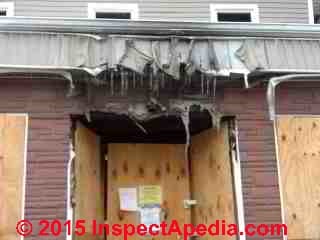
- Bethea, Robert M., Belur N. Murthy, and Donald F. Carey. "Odor controls for rendering plants." Environmental science & technology 7, no. 6 (1973): 504-510.
- Carpenter, Alan B., Douglas K. True, and Edward J. Stanek. "Leaf burning as a significant source of urban air pollution." Journal of the Air Pollution Control Association 27, no. 6 (1977): 574-576.
- Chicora Foundation, "Fire: What is Smoke?", Chicora Foundation, Inc., POB 8664, Columbia SC 29202, Tel: 803-787-6910, Website: chicora.org, Email: info@chicora.org, - retrieved 2 Mar 2015, original source: http://chicora.org/fire.html
- Cigarette smoke:
- Boeniger, Mark F. "Use of ozone generating devices to improve indoor air quality." American Industrial Hygiene Association 56, no. 6 (1995): 590-598.
- Junker, Martin H., Brigitta Danuser, Christian Monn, and Theodor Koller. "Acute sensory responses of nonsmokers at very low environmental tobacco smoke concentrations in controlled laboratory settings." Environmental Health Perspectives 109, no. 10 (2001): 1045.
- Leaderer, Brian P., William S. Cain, Ruth Isseroff, and Larry G. Berglund. "Ventilation requirements in buildings—II. Particulate matter and carbon monoxide from cigarette smoking." Atmospheric Environment (1967) 18, no. 1 (1984): 99-106.
- Matt, Georg E., Penelope JE Quintana, Melbourne F. Hovell, Dale Chatfield, Debbie S. Ma, Romina Romero, and Anna Uribe. "Residual tobacco smoke pollution in used cars for sale: air, dust, and surfaces." Nicotine & tobacco research 10, no. 9 (2008): 1467-1475.
- Okubo, Masaaki, Tomoyuki Kuroki, Hideya Kametaka, and Toshiaki Yamamoto. "Odor control using the AC barrier-type plasma reactors." Industry Applications, IEEE Transactions on 37, no. 5 (2001): 1447-1455.
- Olander, Lars, Johan Johansson, and Rolf Johansson. "Tobacco smoke removal with room air cleaners." Scandinavian journal of work, environment & health (1988): 390-397.
- Dickerson, Richard C., and Belur N. Murthy. "Scope of Wet Scrubbers for Odor Control", Annals of the New York Academy of Sciences 237, no. 1 (1974): 374-388.
- Fultz, Mary Lou, and John D. DeHaan. "Gas chromatography in arson and explosives analysis." Gas Chromatography in Forensic Science. Ellis Horwood Limited, Chichester, England (1992): 109-163.
- Hall, Richard and Barbara Adams, editors. 1998. Essentials of Fire Fighting, Fourth Edition. Stillwater, Oklahoma: Oklahoma State University Press.
- Kuwahara, Takuya, Masaaki Okubo, Tomoyuki Kuroki, Hideya Kametaka, and Toshiaki Yamamoto. "Odor removal characteristics of a laminated film-electrode packed-bed nonthermal plasma reactor." Sensors 11, no. 6 (2011): 5529-5542.
- Lee, Sung Hwa. "Development of photocatalyst plasma air cleaning filter used in air conditioner." Journal of Advanced Oxidation Technologies 6, no. 1 (2003): 66-69.
- National Fire Protection Association. 1997. NFPA 909: Standards for the Protection of Cultural Resources Including Museums, Libraries, Places of Worship, and Historic Properties. Quincy, Massachusetts: National Fire Protection Association.
- National Institute of Disaster Restoration. 1997. NIDR Guidelines for Fire and Smoke Damage Repair. Annapolis Junction, Maryland: Association of Specialists in Cleaning and Restoration
- IICRC: Institute of Inspection, Cleaning, & Restoration Certification, Website: www.iicrc.org, offices in 25 countries including Australia, Canada, United Kingdom, United States, Japan, New Zealand
- RIA: Restoration Industry Association, 2025 M St. NW, Ste. 800, Washington, DC 20036, Tel: 202-367-1180 Website: http://www.restorationindustry.org , Email: info@restorationindustry.org
- Roy, Murari Mohon, Riaz Parvez, and Rabiul Islam Sarker. "Exhaust odor and smoke reduction of stationary DI diesel engines to acceptable level by water-scrubbing and air-dilution system." Applied Energy 88, no. 7 (2011): 2391-2399.
- Stauffer, Eric, Julia A. Dolan, and Reta Newman. Fire debris analysis. Academic Press, 2007.
- Viessman, Warren. "Ventilation control of odor." Annals of the New York Academy of Sciences 116, no. 2 (1964): 630-637.
- Wasserman, Aaron E. "Organoleptic evaluation of three phenols present in wood smoke." Journal of Food Science 31, no. 6 (1966): 1005-1010.
- Zukeran, A., J. Chang, A. A. Berezin, and T. Ito. "Control of ultrafine particles from incense smoke by air cleaning electrostatic precipitators." Journal of Aerosol Science 28, no. 1001 (1997): 289-290.
Reader Comments, Questions & Answers About The Article Above
Below you will find questions and answers previously posted on this page at its page bottom reader comment box.
Reader Q&A - also see RECOMMENDED ARTICLES & FAQs
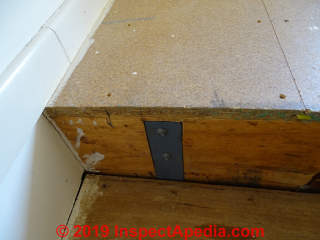 Question: eye & skin irritation & odors from exposed particle board flooring
Question: eye & skin irritation & odors from exposed particle board flooring
We are trying desperately to find information about a flooring problem since we've removed carpet and came across your website. About 3 weeks ago we removed carpet and underlay (green foam pieces) from an upstairs room.
We discovered particle board flooring underneath and there has been a continuous awfully strong odour coming from the room.
The flooring itself is in good condition, not water damaged or pet smell. We've tried everything to clean the space - airpurifier, dehumidifier, hepa vacuum, cleaning baking soda, disinfectant, vinegar and essential oils, and the smell is still there.
It's worse when the area gets really hot but we have to keep the windows open up there for ventilation.
We've had eye and skin irritation, burning stuffiness nose and throat and are now sleeping down the other end of the house! Is it possible that after 15years (approximately) from being covered with the carpet that the floor, now that it's exposed, would be off-gassing nasties like formaldehyde.
I've never smelt anything like it before or had this reaction.
We want to seal it with something but due to existing sensitivities don't know what to use but we need to do something that works. Our aim is to put new timber flooring over the top when we fix the problem so also need something that will be ok underneath other flooring?
If you can help with any information or suggestions would be much appreciated. - Anonymous by private email 2019/12/11
Reply: formaldehyde? Sealants to try
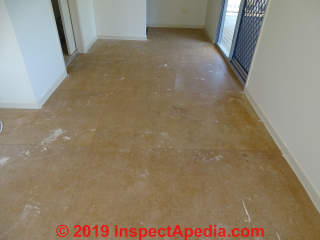 You'll understand that no one with any sense will pretend he or she can tell you what's offgassing from a building material from e-text;
You'll understand that no one with any sense will pretend he or she can tell you what's offgassing from a building material from e-text;
However as you'll read in our article series on formaldehyde off-gassing that could be an irritating off-gas product from particle board.
See details at FORMALDEHYDE GAS HAZARD REDUCTION
and also see FORMALDEHYDE HAZARDS - home
You might have success using one of the paint-sealants commonly used to stop odors in buildings after a fire; many of these are low VOC and after initial drying do not emit odors.
See DISINFECTANTS, SANITIZERS, FUNGICIDAL-SEALANTS SOURCES
Reader follow-up
I've added a couple of photos [shown above - ed] you might want to include in the post.
The first one is at the top of stairwell and the green you can see is just left over from some of the underlay foam. Hope this is useful. I'll look into the odour sealants and try to find one that is low VOC.
Question: questionable odor sealant coating after a house fire
2019/12/05 ranwin33 said:
Can anyone tell me if this is an acceptable result. Remediation company claims the area was treated with a dry ice application and sealed.
I thought sealant had a color to it, and shouldn’t a dry ice application remove all of the charring.
Reply:
Ranwin
Sealants used after a fire can be pigmented (usually white) or clear - in both cases the coating is usually visible. Below is an example of a clear encapsulant that we list
at DISINFECTANTS, SANITIZERS, FUNGICIDAL-SEALANTS SOURCES
I don't know what dry ice method was used nor how thoroughly it was applied. Indeed some media blasting methods can clean wood completely; if the charring was deep into the roof deck or framing the blasting may not have been able to remove it, leading to a more-important question: should some of this roof structure have been replaced, repaired, sistered?
Ask for or take a photo of the sealant product used - showing (probably in a series of photos) ALL of the product information - and we can comment further.
You can as you may have found, post one photo per comment, but as many comments as you need.
Below is another example showing that some sealants are white. This coating is
from FUNGICIDAL SEALANT USE GUIDE
Question: odors embedded in wood kitchen cabinets
(Feb 8, 2018) Ali said:
How can I remove smoke odor from burning toast that smells like it’s embedded in a finished wood kitchen cabinet door?
Reply:
Ali
If the wood surfaces are all finish-coated, you can remove odors by using a detergent cleaner.
Beware that there are probably other materials and surfaces that absorb odor in the same area.
Question: cigarette smoke odors from the apartment downstairs
(Oct 24, 2014) Rob said:
Hi, I wonder if you can advice me about how to stop the very strong smell of cigarette smoke and other domestic (cooking etc.) odors coming up to my apartment from the floor below. I have a converted apartment on the second floor with suspended timber flooring. I'm going to take off the carpet and lift up the floor boards to see what sort of insulation there might be between their ceiling and our floor.
But could you please tell me what sort of specific insulation I'd need to help stop any odors coming up, as well as anything else if necessary, such as vapour barriers or DPMs etc. ?
Would you please also advice on the order of any materials that you may suggest should be put down, all the way to the top layer of carpeting.
Thanks.
Reply:
Look for and seal the air leaks from below, such as around pipes and electrical wires.
Question: how to avoid smoke from my neighbors
(Dec 3, 2014) Tori said:
I live on the 2nd floor of a 2-story apartment building.
The neighbors below me are heavy smokers and smoke outside, but with their door wide open, so consequently, their apartment smells smoky. Both of my bathrooms (located in the middle of my apartment away from any exterior windows and doors) always smell very heavily of smoke.
What would explain this? I wonder if somehow the outdoor air is coming in through our bathroom ventilation
I would like to resolve this problem seeing as I have a baby and don't want her inhaling their 2nd hand smoke.
Reply:
Tori
I think to avoid incoming smoke from windows or doors of a neighoring apartment you'd need to close your own windows and doors or open them just strategically, possibly combined with blowing fresh air into the apartment from a window away from the smoke source - the latter suggestion puts your apartment under positive pressure and will resist smoke coming in from other sources.
Question: homes on stilts [pilings] over a mine area, creosote odors
(Dec 30, 2014) Stephen Dunne Garcia said:
Hi, I have recently purchased a home on the river.
The homes in this area are on stilts and mine has been closed in. The stilts now make a bottom floor. There is a strange tar like smell in the bottom floor of the house where the beams have been incase, or shall I say wrapped by a metal siding cover, slightly exposed
I am worried this is the smell of the treated beams used to keep the house up. What can I do to make the smell go away or to make the lower level livable? How do I know that the scent is creosote?
Reply:
Stephen,
There is more to this situation than just odor. I'm unsure about structural durability, water or moisture issues, and building without a permit.
To test the piling coating you can send a sliver of surface material to an environmental teat lab.
To seal such odors you'd need to enclose the coated items in an airtight wrap - which might give further moisture or rot issues later.
...
Continue reading at CREOSOTE ODOR CURE / REMOVAL or select a topic from the closely-related articles below, or see the complete ARTICLE INDEX.
Or see these
Articles Assisting in Fire & Smoke Odor Source Removal & Prevention
Burning materials in buildings can leave a wide variety of both smelly and harmful odors & gases. At left, the burning vinyl siding & trim on this building were a strong odor source in and around this Poughkeepsie NY home.
- FIRE & SMOKE ODOR REMOVAL - home
- AIR CLEANER PURIFIER TYPES
- CARPETING ODORS
- CHIMNEY CLEARANCE to NEIGHBORS
- CREOSOTE DEPOSITS, FIRE HAZARD
- CREOSOTE ODOR CURE / REMOVAL
- DUCT & AIR HANDLER ODORS
- FIREPLACE & WOODSTOVE CONTAMINANTS
- HEATING SYSTEM ODORS
- ODOR DIAGNOSIS CHECKLIST, PROCEDURE
- ODORS from HVAC SYSTEMS
- ODOR REMOVING DETERGENTS
- OIL BURNER NOISE SMOKE ODORS - home
- OIL BURNER NOISE DIAGNOSTIC INDEX
- OIL LINE BUZZ & VIBRATION CURE
- OIL BURNER SOOT & PUFFBACKS
- OZONE MOLD / ODOR TREATMENT WARNINGS
- PLASTIC ODORS
- PUFFBACKS, OIL BURNER
- SEWAGE CLEANUP PROCEDURES & STANDARDS
- SMELL PATCH TEST to FIND ODOR SOURCE
- STAINS HUMAN OCCUPANT
- WOOD STOVE OPERATION & SAFETY
- ODORS GASES SMELLS, DIAGNOSIS & CURE - home
Suggested citation for this web page
FIRE & SMOKE ODOR REMOVAL at InspectApedia.com - online encyclopedia of building & environmental inspection, testing, diagnosis, repair, & problem prevention advice.
Or see this
INDEX to RELATED ARTICLES: ARTICLE INDEX to BUILDING ODOR DIAGNOSIS & CURE
Or use the SEARCH BOX found below to Ask a Question or Search InspectApedia
Ask a Question or Search InspectApedia
Try the search box just below, or if you prefer, post a question or comment in the Comments box below and we will respond promptly.
Search the InspectApedia website
Note: appearance of your Comment below may be delayed: if your comment contains an image, photograph, web link, or text that looks to the software as if it might be a web link, your posting will appear after it has been approved by a moderator. Apologies for the delay.
Only one image can be added per comment but you can post as many comments, and therefore images, as you like.
You will not receive a notification when a response to your question has been posted.
Please bookmark this page to make it easy for you to check back for our response.
Our Comment Box is provided by Countable Web Productions countable.ca
Citations & References
In addition to any citations in the article above, a full list is available on request.
- Bethea, Robert M., Belur N. Murthy, and Donald F. Carey. "Odor controls for rendering plants." Environmental science & technology 7, no. 6 (1973): 504-510.
- Carpenter, Alan B., Douglas K. True, and Edward J. Stanek. "Leaf burning as a significant source of urban air pollution." Journal of the Air Pollution Control Association 27, no. 6 (1977): 574-576.
- Chicora Foundation, "Fire: What is Smoke?", Chicora Foundation, Inc., POB 8664, Columbia SC 29202, Tel: 803-787-6910, Website: chicora.org, Email: info@chicora.org, - retrieved 2 Mar 2015, original source: http://chicora.org/fire.html
- Boeniger, Mark F. "Use of ozone generating devices to improve indoor air quality." American Industrial Hygiene Association 56, no. 6 (1995): 590-598.
- Junker, Martin H., Brigitta Danuser, Christian Monn, and Theodor Koller. "Acute sensory responses of nonsmokers at very low environmental tobacco smoke concentrations in controlled laboratory settings." Environmental Health Perspectives 109, no. 10 (2001): 1045.
- Leaderer, Brian P., William S. Cain, Ruth Isseroff, and Larry G. Berglund. "Ventilation requirements in buildings—II. Particulate matter and carbon monoxide from cigarette smoking." Atmospheric Environment (1967) 18, no. 1 (1984): 99-106.
- Matt, Georg E., Penelope JE Quintana, Melbourne F. Hovell, Dale Chatfield, Debbie S. Ma, Romina Romero, and Anna Uribe. "Residual tobacco smoke pollution in used cars for sale: air, dust, and surfaces." Nicotine & tobacco research 10, no. 9 (2008): 1467-1475.
- Okubo, Masaaki, Tomoyuki Kuroki, Hideya Kametaka, and Toshiaki Yamamoto. "Odor control using the AC barrier-type plasma reactors." Industry Applications, IEEE Transactions on 37, no. 5 (2001): 1447-1455.
- Olander, Lars, Johan Johansson, and Rolf Johansson. "Tobacco smoke removal with room air cleaners." Scandinavian journal of work, environment & health (1988): 390-397.
- Dickerson, Richard C., and Belur N. Murthy. "Scope of Wet Scrubbers for Odor Control", Annals of the New York Academy of Sciences 237, no. 1 (1974): 374-388.
- Hall, Richard and Barbara Adams, editors. 1998. Essentials of Fire Fighting, Fourth Edition. Stillwater, Oklahoma: Oklahoma State University Press.
- Kuwahara, Takuya, Masaaki Okubo, Tomoyuki Kuroki, Hideya Kametaka, and Toshiaki Yamamoto. "Odor removal characteristics of a laminated film-electrode packed-bed nonthermal plasma reactor." Sensors 11, no. 6 (2011): 5529-5542.
- Lee, Sung Hwa. "Development of photocatalyst plasma air cleaning filter used in air conditioner." Journal of Advanced Oxidation Technologies 6, no. 1 (2003): 66-69.
- National Fire Protection Association. 1997. NFPA 909: Standards for the Protection of Cultural Resources Including Museums, Libraries, Places of Worship, and Historic Properties. Quincy, Massachusetts: National Fire Protection Association.
- National Institute of Disaster Restoration. 1997. NIDR Guidelines for Fire and Smoke Damage Repair. Annapolis Junction, Maryland: Association of Specialists in Cleaning and Restoration
- IICRC: Institute of Inspection, Cleaning, & Restoration Certification, Website: www.iicrc.org, offices in 25 countries including Australia, Canada, United Kingdom, United States, Japan, New Zealand
- RIA: Restoration Industry Association, 2025 M St. NW, Ste. 800, Washington, DC 20036, Tel: 202-367-1180 Website: http://www.restorationindustry.org , Email: info@restorationindustry.org
- Roy, Murari Mohon, Riaz Parvez, and Rabiul Islam Sarker. "Exhaust odor and smoke reduction of stationary DI diesel engines to acceptable level by water-scrubbing and air-dilution system." Applied Energy 88, no. 7 (2011): 2391-2399.
- Viessman, Warren. "Ventilation control of odor." Annals of the New York Academy of Sciences 116, no. 2 (1964): 630-637.
- Wasserman, Aaron E. "Organoleptic evaluation of three phenols present in wood smoke." Journal of Food Science 31, no. 6 (1966): 1005-1010.
- Zukeran, A., J. Chang, A. A. Berezin, and T. Ito. "Control of ultrafine particles from incense smoke by air cleaning electrostatic precipitators." Journal of Aerosol Science 28, no. 1001 (1997): 289-290.
- ASTM E2600 - 08 Standard Practice for Assessment of Vapor Intrusion into Structures on Property Involved in Real Estate Transactions is available from the ASTM at astm.org/Standards/E2600.htm .
"This practice is intended for use on a voluntary basis by parties who wish to conduct a VIA on a parcel of real estate, or more specifically conduct a screening evaluation to determine whether or not there is potential for a VIC, and if so, identify alternatives for further investigation."
The standard goes on to emphasize the uncertainty in testing any site for gases and vapor intrusion. - [6] Brett C. Singer, Beverly K. Coleman, Hugo Destaillats, Alfred T. Hodgson, Melissa M. Lunden, Charles J. Weschler, William W Nazaroff, "Indoor secondary pollutants from cleaning product and air freshener use in the presence of ozone", Atmospheric Environment, Volume 40, Issue 35, November 2006, Pages 6696–6710
Abstract This study investigated the formation of secondary pollutants resulting from household product use in the presence of ozone. Experiments were conducted in a 50-m3 chamber simulating a residential room. The chamber was operated at conditions relevant to US residences in polluted areas during warm-weather seasons: an air exchange rate of 1.0 h−1 and an inlet ozone concentration of approximately 120 ppb, when included. Three products were used in separate experiments. An orange oil-based degreaser and a pine oil-based general-purpose cleaner were used for surface cleaning applications. A plug-in scented-oil airfreshener (AFR) was operated for several days. Cleaning products were applied realistically with quantities scaled to simulate residential use rates. Concentrations of organic gases and secondary organic aerosol from the terpene-containing consumer products were measured with and without ozone introduction. In the absence of reactive chemicals, the chamber ozone level was approximately 60 ppb. Ozone was substantially consumed following cleaning product use, mainly by homogeneous reaction. For the AFR, ozone consumption was weaker and heterogeneous reaction with sorbed AFR-constituent VOCs was of similar magnitude to homogeneous reaction with continuously emitted constituents. Formaldehyde generation resulted from product use with ozone present, increasing indoor levels by the order of 10 ppb. Cleaning product use in the presence of ozone generated substantial fine particle concentrations (more than 100 μg m−3) in some experiments. Ozone consumption and elevated hydroxyl radical concentrations persisted for 10–12 h following brief cleaning events, indicating that secondary pollutant production can persist for extended periods.
Keywords Air quality; Formaldehyde; Indoor air chemistry; Secondary organic aerosol; Terpenes - [7] Xiaoyu Liu,*† Mark Mason, Kenneth Krebs, and Leslie Sparks, "Full-Scale Chamber Investigation and Simulation of Air Freshener Emissions in the Presence of Ozone:, Environ. Sci. Technol., 2004, 38 (10), pp 2802–2812 DOI: 10.1021/es030544b Publication Date (Web): April 9, 2004,
- [8] RI Vanhegan, R.G. Mitchell, "Pseudomonas Infection Associated with Contamination of Wick-Type Air Freshener", British Medical Journal, 20 Sept. 1975, pp. 685 [copy on file as Air_Fresh_Study_BMJ75.pdf]
- [9] Salthammer, T. (ed) (2007) Subject Index, in Organic Indoor Air Pollutants: Occurrence - Measurement - Evaluation, Wiley-VCH Verlag GmbH, Weinheim, Germany. doi: 10.1002/9783527613663.indsub
- [10] Mihalis Lazaridis (Editor), Ian Colbeck (Editor), Human Exposure to Pollutants via Dermal Absorption and Inhalation(Environmental Pollution), Springer; 1st Edition. edition (April 1, 2010), ISBN-10: 9048186625 ISBN-13: 978-9048186624
- [14] Thomas M. Riddick, "Controlling Taste, Odor and Color With Free Residual Chlorination", Journal (American Water Works Association) Vol. 43, No. 7 (JULY 1951), pp. 545-552, American Water Works Association, Article Stable URL: http://www.jstor.org/stable/41236445
- [17] Jon H. Ruth, "Odor Thresholds and Irritation Levels of Several Chemical Substances: A Review", American Industrial Hygiene Association Journal Volume 47, Issue 3, 1986, retrievedf 9/22/12, Abstract: A collation of odor threshold data for approximately 450 chemical substances is presented. The range of odor thresholds reported in the literature is shown along with any reported threshold of irritation to humans. These data can assist the industrial hygienist in determining when an “odor” may be in excess of the Threshold Limit Value®, when an organic vapor respirator is not acceptable due to the lack of an odor warning at the end of a cartridge life, and where odors may not indicate a hazard due to extremely low odor thresholds which may be well below the respective TLVs.
- Kansas State University, department of plant pathology, extension plant pathology web page on wheat rust fungus: see http://www.oznet.ksu.edu/path-ext/factSheets/Wheat/Wheat%20Leaf%20Rust.asp
- A BRIEF GUIDE to MOLD, MOISTURE, and YOUR HOME, [PDF] U.S. Environmental Protection Agency US EPA - includes basic advice for building owners, occupants, and mold cleanup operations. See http://www.epa.gov/mold/moldguide.htm
- US EPA - Mold Remediation in Schools and Commercial Building [ copy on file as /sickhouse/EPA_Mold_Remediation_in_Schools.pdf ] - US EPA
- A BRIEF GUIDE to MOLD, MOISTURE, and YOUR HOME, [PDF] U.S. Environmental Protection Agency US EPA - includes basic advice for building owners, occupants, and mold cleanup operations. See http://www.epa.gov/mold/moldguide.htm
- Disease Prevention in Home Vegetable Gardens [PDF], Patricia Donald,Department of Plant Microbiology and Pathology,
Lewis Jett
Department of Horticulture, University of Missouri Extension - extension.missouri.edu/publications/DisplayPub.aspx?P=G6202 - US EPA: Mold Remediation in Schools and Commercial Building [ copy on file as /sickhouse/EPA_Mold_Remediation_in_Schools.pdf ] - US EPA
- In addition to citations & references found in this article, see the research citations given at the end of the related articles found at our suggested
CONTINUE READING or RECOMMENDED ARTICLES.
- Carson, Dunlop & Associates Ltd., 120 Carlton Street Suite 407, Toronto ON M5A 4K2. Tel: (416) 964-9415 1-800-268-7070 Email: info@carsondunlop.com. Alan Carson is a past president of ASHI, the American Society of Home Inspectors.
Thanks to Alan Carson and Bob Dunlop, for permission for InspectAPedia to use text excerpts from The HOME REFERENCE BOOK - the Encyclopedia of Homes and to use illustrations from The ILLUSTRATED HOME .
Carson Dunlop Associates provides extensive home inspection education and report writing material. In gratitude we provide links to tsome Carson Dunlop Associates products and services.


